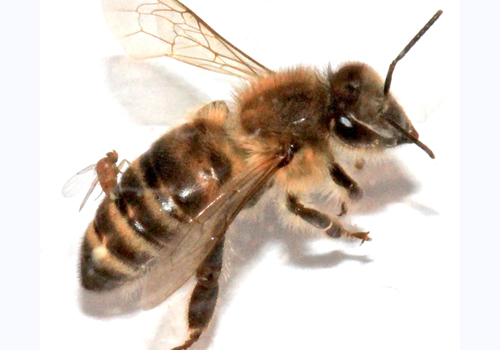ZomBee Watch, a new citizen-scientist project
“If the bee disappeared off the surface of the globe, man would have only four years to live”.
— Albert Einstein
![]()
No, there are no typos in the title. And, no, there is no zombie outbreak towards which people are being recruited to fight. (Well, yeah, that’s what “they” always say isn’t it?) The ZomBee Watch project is concerned with honeybees, and a probable contributing cause to colony-collapse disorder or CCD. CCD has decimated beehives across North America and Europe. Many possible causes have been investigated including loss of genetic diversity leading to vulnerability, parasitic mites that carry a lethal virus, fungi, pesticides and various combinations of the above named factors and others. Since honeybees pollinate so many of our crops, there is a real concern for food security if worldwide bee population drops. Also, wild plant diversity can be threatened, opening the way to ecosystem changes.
One possible contributor to CCD is this little guy (or rather gal):
See the little fly riding the bee’s back? That’s the female Apocephalus borealis, laying its eggs in the bee. A. borealis’s larva hatch within the bee, causing it to leave the hive at night and be attracted to lights. The bee dies, while the larva leave it and pupate around it. New flies then emerge, which will infect more bees.
So the citizen scientist project ZomBee Watch, from San Francisco State University and The Natural History Museum of Los Angeles County aims to find out how widespread Zombie Fly (as they call the borealis) infections are. They would like people help them establish a baseline for the number of bees that leave the hive at night, and how many are infected by the Zombie Fly. From their website:
There are many ways you can get involved. It can be as easy as collecting honey bees that are under your porch light in the morning, under a street light or stranded on sidewalks. If you are a beekeeper, setting up a light trap near one of your hives is the most effective way to detect ZomBees. It’s easy to make a simple, inexpensive light trap from materials available at your local hardware store. To test for the presence of Zombie Fly infection all you need to do is put honey bees you collect in a container and observe them periodically. Infected honey bees give rise to brown pill-like fly pupae in about a week and to adult flies a few weeks later.
And a slide tutorial:
Go forth and stop the zombee apocalypse! The ZomBee Watch site has more information on how to join. Also, read their paper in PLoS ONE.
Andrew Core, Charles Runckel, Jonathan Ivers, Christopher Quock, Travis Siapno, Seraphina DeNault, Brian Brown, Joseph DeRisi, Christopher D. Smith, & John Hafernik (2012). A New Threat to Honey Bees, the Parasitic Phorid Fly Apocephalus borealis PLoS ONE : 10.1371/journal.pone.0029639




















Does the fly attack only honeybees or also other kind of bees?
It’s known to attack bumblebees. I understand that the whole honeybee thing is new, and they are not sure of the extent of the attacks. Hence this request for observations.